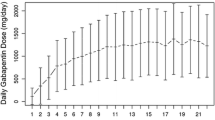Abstract
Introduction
Subarachnoid haemorrhage (SAH) is usually associated with severe headache, whereas the options of pharmacological analgesia are restricted. Acupuncture is a promising method in treatment of headaches associated with meningeal sensitivity or irritation, such as migraine or post-dural puncture headache.
Case Report
We report on 3 patients, who suffered severe headache due to aneurysmal SAH, and received acupuncture when pharmacological measures were exhausted. After acupuncture treatment all patients reported at least 50% pain reduction and could stop or reduce analgesics without side effects.
Discussion
Acupuncture may be an effective pain treatment method in patients suffering from headache due to SAH. Randomized trials using acupuncture as an add-on to standard analgesic therapy would help evaluate the role of acupuncture for this purpose.


Similar content being viewed by others
References
Glisic EK, Gardiner L, Josti L, et al. Inadequacy of headache management after subarachnoid hemorrhage. Am J Crit Care. 2016;25:136–43.
Morad AH, Tamargo RJ, Gottschalk A. The longitudinal course of pain and analgesic therapy following aneurysmal subarachnoid hemorrhage: a cohort study. Headache. 2016;56:1617–25.
Singh M, Guth JC, Liotta E, et al. Predictors of 30-day readmission after subarachnoid hemorrhage. Neurocrit Care. 2013;19:306–10.
Ogden J, Utley T, Mee E. Neurological and psychological outcome 4 to 7 years after subarachnoid hemorrhage. Neurosurgery. 1997;41:25–34.
Rabinstein AA, Lanzino G, Wijdicks EF. Multidisciplinary management and emerging therapeutic strategies in aneurysmal subarachnoid haemorrhage. Lancet Neurol. 2010;9:504–19.
Linde K, Allais G, Brinkhaus B, et al. Acupuncture for the prevention of episodic migraine. Cochrane Database Syst Rev. 2016;6:CD001218.
Dietzel J, Witstruck T, Adler S, Usichenko TI. Acupuncture for treatment of therapy-resistant post-dural puncture headache: a retrospective case series. Br J Anaesth. 2013;111:847–9.
Coeytaux RR, Befus D. Role of acupuncture in the treatment or prevention of migraine, tension-type headache, or chronic headache disorders. Headache. 2016;56:1238–40.
Xinnong C. Chinese acupuncture and moxibustion. 1st ed. Beijing: Foreign Languages Press; 1987. p. 429–32.
WHO. Third WHO regional working group on standardization of acupuncture nomenclature. Seoul: WHO; 1987.
Ko CN, Lee IW, Cho SY, et al. Acupuncture for cerebral vasospasm after subarachnoid hemorrhage: a retrospective case–control study. J Altern Complement Med. 2013;19:471–3.
Sun J, Liu Y, Zhang J, et al. Electroacupuncture improves cerebral vasospasm and functional outcome of patients with aneurysmal subarachnoid hemorrhage. Front Neurosci. 2018;12:724.
Cho SY, Lee DH, Shin HS, et al. The efficacy and safety of acupuncture for cerebral vasospasm after subarachnoid hemorrhage: study protocol for a randomized controlled trial. Trials. 2015;16:68.
He W, Zhao X, Li Y, Xi Q, Guo Y. Adverse events following acupuncture: a systematic review of the Chinese literature for the years 1956–2010. J Altern Complement Med. 2012;18:892–901.
Witt CM, Pach D, Brinkhaus B, Wruck K, Tag B, Mank S, Willich SN. Safety of acupuncture: results of a prospective observational study with 229,230 patients and introduction of a medical information and consent form. Forsch Komplementmed. 2009;16:91–7.
Acknowledgements
The authors thank Dr. Mike Cummings for preparation of figures and language correction of the manuscript and Dr. Cornelia Koch for her clinical advice.
Author information
Authors and Affiliations
Contributions
J.D. was involved in the treatment of patients using acupuncture, data collection and interpretation, and writing the MS; T.E. contributed to management of patients at ICU, data collection, and writing the MS; and T.U. was involved in the idea of the investigation, treatment of patients, data interpretation, and writing the MS.
Corresponding author
Ethics declarations
Source of support
There was no support for this work.
Conflict of interest
The authors declare that they have no competing interests.
Informed Consent
Informed consent was received from each patient, and ethics commission has approved this retrospective case series investigation.
Additional information
Publisher's Note
Springer Nature remains neutral with regard to jurisdictional claims in published maps and institutional affiliations.
Rights and permissions
About this article
Cite this article
Dietzel, J., Eck, T. & Usichenko, T. Treating Therapy-Resistant Headache After Aneurysmal Subarachnoid Hemorrhage with Acupuncture. Neurocrit Care 31, 434–438 (2019). https://doi.org/10.1007/s12028-019-00718-3
Published:
Issue Date:
DOI: https://doi.org/10.1007/s12028-019-00718-3




